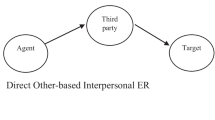Abstract
In recent years a considerable amount of research on nonverbal behavior has focused on identifying patterns of exchange in the component behaviors of interpersonal intimacy. The rapidly developing empirical research, occasionally giving hope for some convergence in the results, has precipitated efforts at explaining the processes underlying the exchange of intimacy. This paper attempts to analyze issues surrounding two of the more promising mediators of intimacy exchange—arousal change and cognitive labeling. This speculative discussion is offered as a means of stimulating several specific and empirically testable questions which may promote our understanding of the intimacy exchange process.
Similar content being viewed by others
References
Argyle, M., & Dean, J. Eye-contact, distance, and affiliation.Sociometry, 1965,28, 289–304.
Baum, A., & Greenberg, C. I. Waiting for a crowd: The behavioral and perceptual effects of anticipated crowding.Journal of Personality and Social Psychology, 1975,32, 671–679.
Helson, H.Adaptation level theory. New York: Harper & Row, 1964.
Ickes, W., & Barnes, R. D. The role of sex and self-monitoring in unstructured settings.Journal of Personality and Social Psychology, 1977,35, 315–330.
Leventhal, H. Emotions: A basic problem for social psychology. In C. Nemeth (Ed.),Social psychology: Classic and contemporary integrations. Chicago: Rand McNally, 1974.
Mandler, G.Mind and emotion. New York: Wiley, 1975.
Patterson, M. L. An arousal model of interpersonal intimacy.Psychological Review, 1976,83, 235–245.
Schachter, S. The interaction of cognitive and physiological determinants of emotional state. In L. Berkowitz (Ed.),Advances in experimental social psychology (Vol. 1). New York: Academic Press, 1964.
Snyder, M. The self-monitoring of expressive behavior.Journal of Personality and Social Psychology, 1974,30, 526–537.
Worchel, S., & Teddlie, C. The experience of crowding: A two-factor theory.Journal of Personality and Social Psychology, 1976,34, 30–40.
Reference Notes
Ellsworth, P. C. Some questions about the role of arousal in the interpretation of direct gaze. Paper presented at the annual meeting of the American Psychological Association, San Francisco, August 1977.
Knowles, E. S. Affective and cognitive mediators of spatial behavior. Paper presented at the annual meeting of the American Psychological Association, San Francisco, August 1977.
Author information
Authors and Affiliations
Additional information
This article is a revision of a paper presented as part of a symposium on Nonverbal Intimacy and arousal: Theoretical approaches and issues at the American Psychological Association Convention, San Francisco August 1977. The author would like to express thanks to the other panel members—Jack Aiello, James Dabbs, Jr., Phoebe Ellsworth, Eric Knowles, and Steve Worchel—for their symposium participation which facilitated the evolution of this paper.
Rights and permissions
About this article
Cite this article
Patterson, M.L. Arousal change and cognitive labeling: Pursuing the mediators of intimacy exchange. J Nonverbal Behav 3, 17–22 (1978). https://doi.org/10.1007/BF01114529
Issue Date:
DOI: https://doi.org/10.1007/BF01114529




